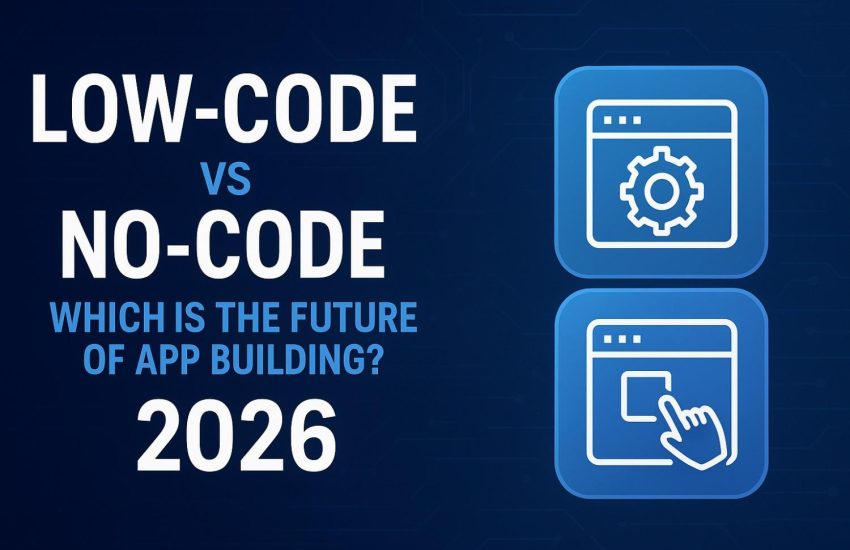The world of app development is evolving faster than ever. Businesses, entrepreneurs, and developers are constantly looking for faster and more cost-effective ways to build apps. Two powerful approaches—low-code and no-code development—have emerged as game-changers. As we approach 2026, the question isn’t whether these platforms will dominate but which one is the future of app building.
In this in-depth guide, we’ll explore low-code vs no-code development, their advantages, key differences, and how they’re shaping the future of app development. Whether you’re a startup owner, a developer, or a tech enthusiast, this article will help you decide which path is right for you.
What Is Low-Code Development?
Low-code development platforms allow developers to build applications with minimal hand-coding. These platforms provide a visual interface with drag-and-drop components while still allowing users to write custom code when needed.
Key Features of Low-Code Platforms
- Visual workflow editors and reusable templates
- Ability to integrate custom scripts and APIs
- Advanced scalability for complex enterprise applications
- Faster development cycles compared to traditional coding
Popular Low-Code Platforms in 2026
- OutSystems – Enterprise-grade apps with strong integration features
- Mendix – Great for complex business solutions
- Microsoft Power Apps – Perfect for organizations using Microsoft ecosystems
Low-code is ideal for professional developers who want to accelerate development while keeping full control over the app’s backend logic.
What Is No-Code Development?
No-code development platforms are designed for non-technical users. These tools allow people to build apps using drag-and-drop interfaces without writing a single line of code. Entrepreneurs, small businesses, and creators can create fully functional apps in days instead of months.
Key Features of No-Code Platforms
- 100% visual development environment
- Pre-built templates and widgets
- Integration with third-party services like Stripe, Zapier, or Google Sheets
- User-friendly design for anyone with minimal tech knowledge
Popular No-Code Platforms in 2026
- Bubble – A leading platform for building web apps
- Adalo – Perfect for mobile app creation
- Glide – Great for creating database-driven apps
No-code is ideal for startups and business owners who want to launch an MVP (Minimum Viable Product) quickly and without hiring developers.
Low-Code vs No-Code: Key Differences
To decide which platform is right for you, let’s break down the low-code vs no-code comparison:
| Feature | Low-Code | No-Code |
|---|---|---|
| Target Audience | Developers & IT Teams | Non-technical users, entrepreneurs |
| Customization | High – allows custom coding | Limited – mostly visual templates |
| Speed of Development | Fast | Very Fast |
| App Complexity | Complex enterprise-grade apps | Simple to moderately complex apps |
| Cost | Moderate to High | Low to Moderate |
Advantages of Low-Code Development
Low-code development is not just about speed—it’s about control and scalability. Here are the key benefits:
- Faster Time to Market: Build apps in weeks instead of months.
- Scalability: Perfect for large organizations that need apps to handle millions of users.
- Flexibility: Developers can add custom scripts and APIs for complex workflows.
- Enterprise Integration: Easily connect with legacy systems and databases.
Advantages of No-Code Development
No-code development empowers non-programmers to create apps without hiring a development team. Benefits include:
- Cost-Effective: Avoid expensive developer fees.
- Speed: Launch a fully functional app in days.
- Accessibility: Anyone with an idea can build an app.
- Rapid Prototyping: Great for startups testing their product-market fit.
The Future of App Development in 2026
The global low-code and no-code market is projected to surpass $65 billion by 2027 (source: Gartner). Here are key trends shaping the future:
1. AI-Powered App Building
AI integration will allow platforms to automatically suggest designs, generate workflows, and debug apps in real-time.
2. Hybrid Development
Expect to see hybrid platforms combining the flexibility of low-code with the simplicity of no-code for ultimate app-building efficiency.
3. Industry Adoption
Sectors like healthcare, e-commerce, and finance will increasingly adopt low-code/no-code to quickly create custom solutions.
4. Enterprise Demand
Large companies will prefer low-code platforms for mission-critical applications, while startups will continue to rely on no-code to test MVPs.
Low-Code or No-Code: Which Should You Choose?
Your choice depends on your needs, budget, and technical skills:
- Choose Low-Code if:
- You need a highly customizable, enterprise-grade application.
- Your team includes professional developers.
- Scalability and backend complexity are key.
- Choose No-Code if:
- You’re a startup or entrepreneur building an MVP quickly.
- You want to avoid hiring developers.
- You need a simple app with limited custom logic.
Top Use Cases in 2026
- Low-Code: Banking apps, supply chain management tools, ERP systems.
- No-Code: E-commerce stores, internal company dashboards, booking apps.
Conclusion: The Winner for 2026
So, which is the future of app building—low-code or no-code?
The answer is both.
- No-code platforms will dominate the startup and small business landscape, enabling rapid innovation and affordable app creation.
- Low-code platforms will remain the top choice for large enterprises that require complex, secure, and scalable applications.
The real future lies in hybrid platforms that blend the best of both worlds, offering flexibility, speed, and accessibility for everyone.

